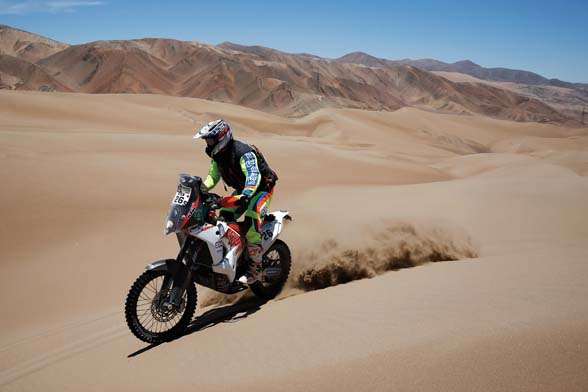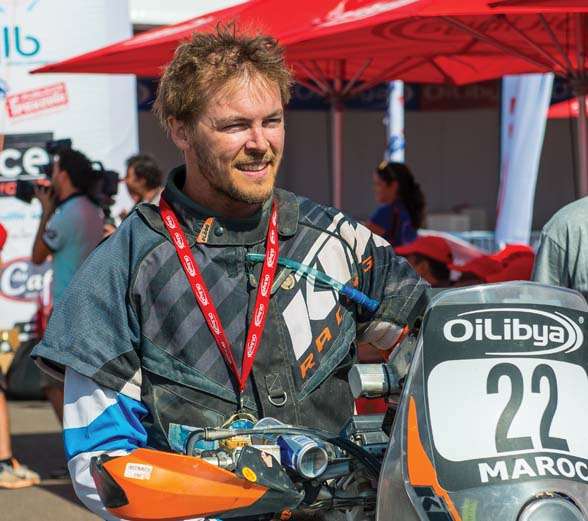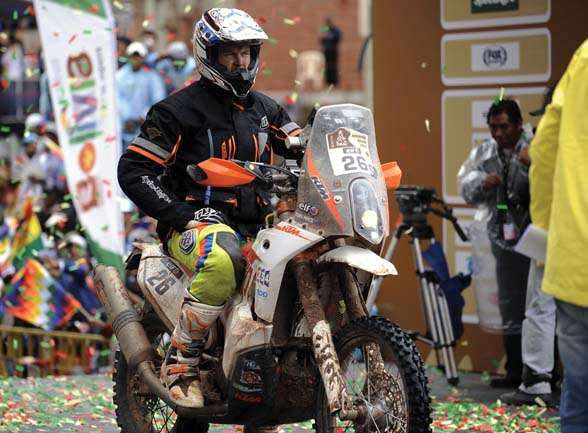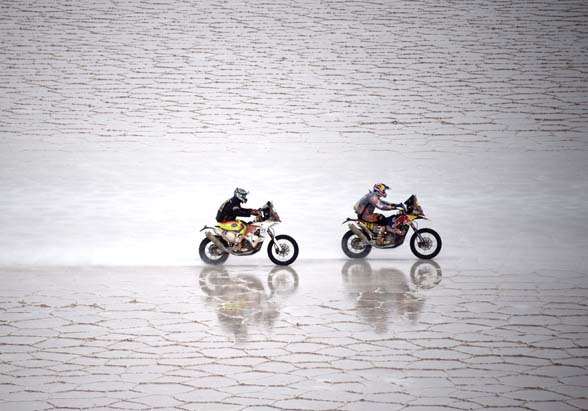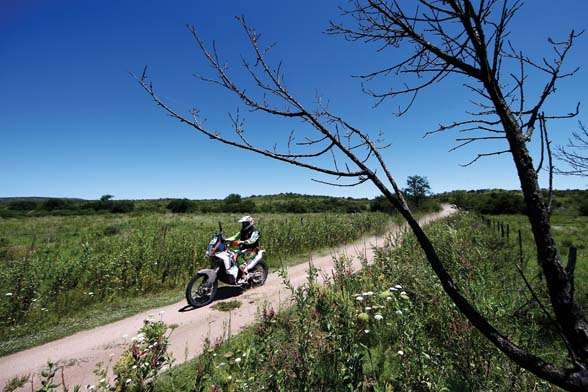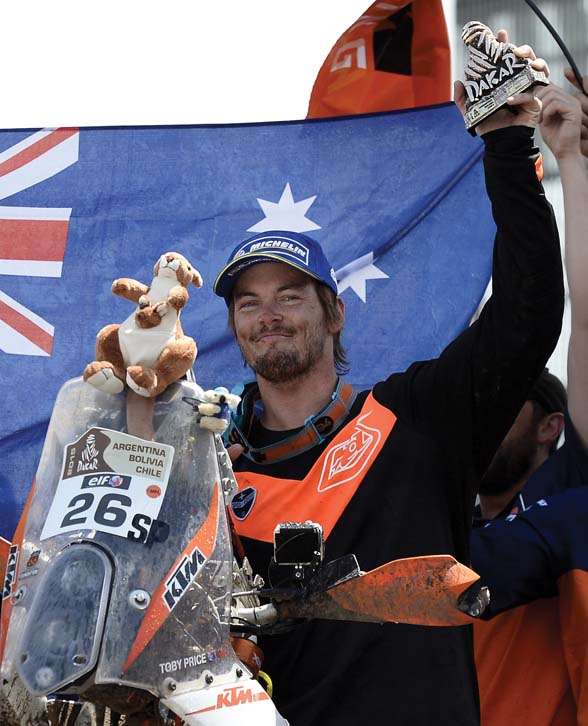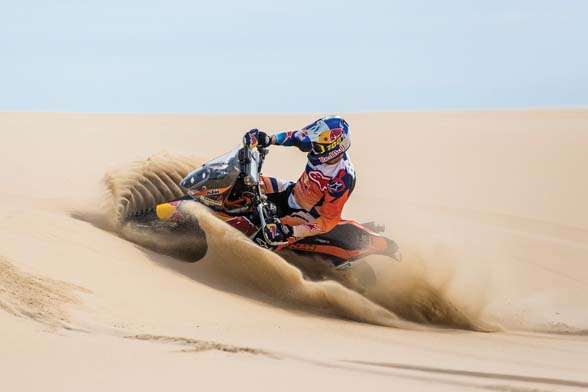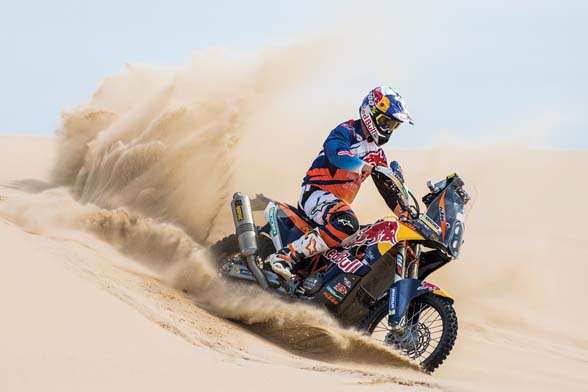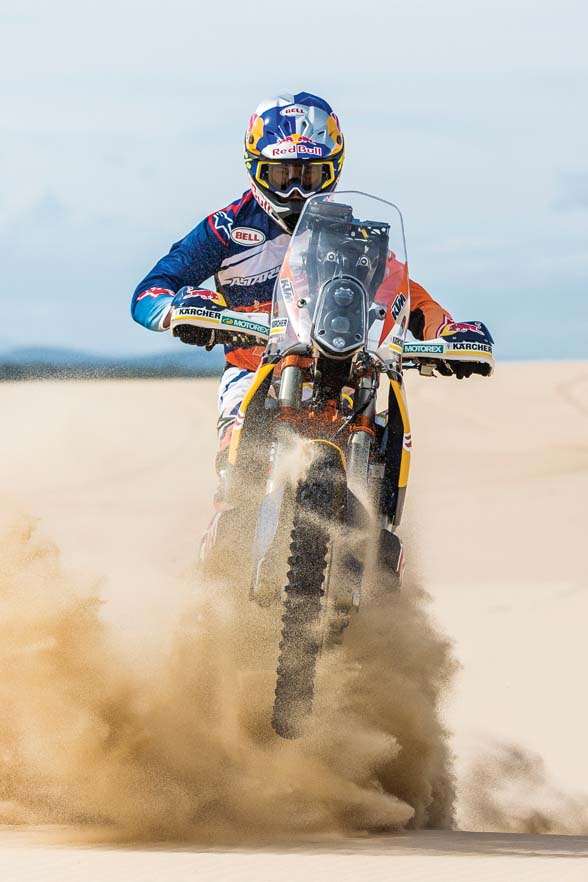This Australian rider just might win the toughest off-road rally on Earth.
Forty years after Dakar’s genesis, Australian Toby Price just might win the toughest off-road rally on Earth.
Forget the myth: it was Jean-Claude Bertrand who had the grand notion of an extreme off-road odyssey traversing the deserts of north Africa. Thirty-eight champagne-fuelled motorcyclists took up the challenge on Boxing Day 1975; most survived the 8600km ordeal from the Cote d’Ivoire to Algiers, to continue their new year’s carousing on the Cote d’Azur. Yet the “Abidjan to Nice Rally” never made news until the following year when Thierry Sabine became lost in the Tenere Desert for three days. He was rescued by none other than Jean-Claude Bertrand, but it was Sabine’s name that made the headlines. Seizing the opportunity sparked by the publicity, Sabine repaid Bertrand by purloining his concept, rebranding the event “Paris to Dakar” and claiming authorship.
Held in the grip of winter, when the only alternative TV sport was “Pub Darts Anglaise”, the Paris to Dakar proved phenomenally newsworthy as an eclectic bunch of motorcyclists, now joined by enthusiasts in stripped-out sedans, dune buggies and butchered 4WDs, blasted across the sunny deserts of Morocco, Mauritania and Mali. Ten years on, these enthusiastic amateurs were joined by a score of highly paid professionals embroidered in colourful shades of Gitanes, Gauloises, Cinzano and Courvoisier. Manufacturers such as BMW, Honda, Yamaha, Citroen, Peugeot and Porsche poured fortunes into promoting Le Dakar as the ultimate product test.
As promoter and benefactor, Sabine shot to fame and fortune. When he died in a helicopter accident in 1986, the Paris-based Amaury Sport Organisation (ASO), organisers of the Tour de France, were quick to take control, trademarking the name Dakar, consolidating the global TV rights and placing former race-winner Hubert Auriol in command of the event ... One in which the French retained a stranglehold, with pilotes francaise amassing an incredible 19 motorcycle victories in 22 years.
Down Under, the expense and logistics of participating in Le Dakar proved insurmountable and, while the event was referred to in awe by hard-core desert racers, it remained an obscurity. Indeed, when South Australian Andy Haydon won the 1997 Australian Safari, giving KTM its first international victory, it was headline news in The Bunyip, Gawler’s leading newspaper, but didn’t quite make it on to Wide World Of Sports. It did, however, appear on the radar at KTM HQ in Austria, prompting an offer to Haydon of a cut-price shot at Dakar. As Haydon recalls, “I was one of four riders sharing a KTM mechanic who didn’t speak English, and my bike was the last to be serviced each night – even though I was often the first to finish. But by day ten, when the others had dropped out, I had the mechanic to myself; and a few of the factory ‘special parts’ found their way on to my bike.”
Despite decidedly low-rent treatment, Haydon won two of the longest stages in Dakar history and was one of the few riders to survive a sandstorm that reduced visibility to less than two metres. It was the first time an Australian had fronted the Dakar startline, with most observers predicting a DNF. Yet when Haydon scored a podium, the first rookie to do so, Aussie riders began considering Dakar no more gruelling than our own Australian Safari. After all, it was only three times the length and eight times the expense ... In an era before social media would bombard all and sundry with the most irrelevant details, the knowledge of just how forbidding the conditions were in north Africa remained close to Haydon’s chest. However, he did pass on what he’d learnt to regular riding mates Andy Caldecott and Dave Schwarz.
After four consecutive wins in the Australian Safari, it was Caldecott who next took up the challenge, only to break an ankle early in the 2004 Dakar. The following year he returned and won a stage in Morocco, but by the time the circus rolled into Dakar, he’d faded to sixth and dashed Australia’s hopes of having a podium contender; if Caldy couldn’t do it, no one could. And when the following year Caldecott was killed, it devastated Australia’s off-road motorcycle community. A small number of riders persevered, but without any genuine podium contenders, Australian fans simply lost interest.
For some years ASO had contributed to the economies of Dakar’s host countries, principally Morocco, Mali, Mauritania and Senegal – countries where the political situation wasn’t always conducive to a bunch of very visibly wealthy invaders making merry. There had always been stories of occasional pot shots being taken by irate tribesmen at competitors’ vehicles, but there was no mistaking the explicit threats made by terrorists only a week out from the 2008 Dakar. Amaury had little option but to can the whole show, much to the chagrin of the competitors who felt the terrorist threats simply added a little frisson to the occasion; besides, they claimed to be much faster than a crowd of blokes crammed into the tray of a Toyota ute trying to aim a .50 cal machine gun. Naturally, ASO’s insurance brokers felt otherwise.
Alternate venues were severely limited. The Serengeti. Siberia. Or South America? The last proved an inspired choice, a continent overflowing with youngbloods who believe they’re genetically linked to Juan Manuel Fangio, pray to the same divine power Ayrton Senna once did, and have a relative born in the same town as Juan Pablo Montoya. And all believing they enjoy the same skills as Carlos Sainz. To everyone’s delight, it seemed the entire populations of Argentina and Chile embraced the spectacle. The European teams were pleased to head south for the winter, none more so than the moto riders. For the first time the Americans and Canadians felt the same; better balmy Buenos Aires than snowbound Chicago. From the Australians’ point of view, crossing the Pacific was far easier and considerably less expensive than the kangaroo hop to Europe and the horrendous logistics of returning home from north Africa; this was just the opportunity we’d been hoping for. Surely we had someone who could showcase our talent ...
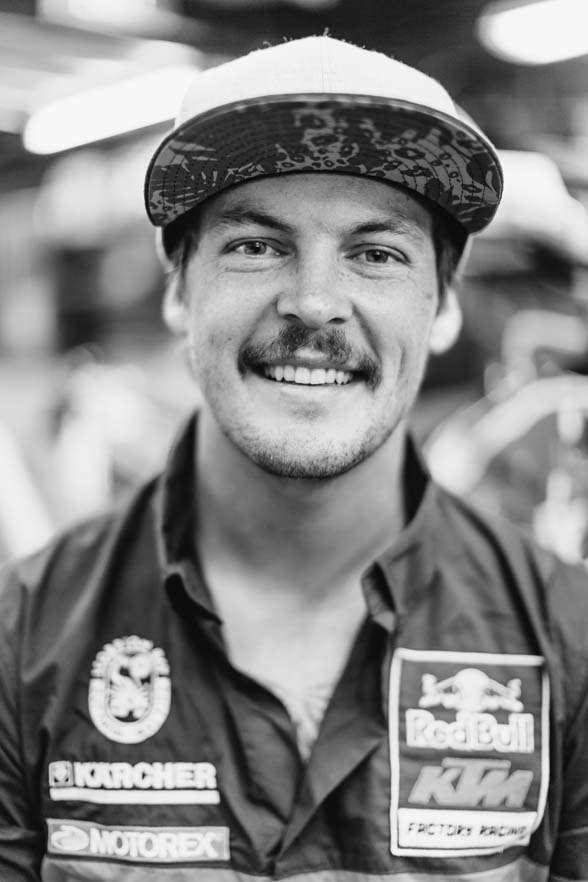 Image courtesy Red Bull Content Pool.
Image courtesy Red Bull Content Pool.Our acknowledged “King of the Desert” was triple Australian Safari winner Ben Grabham, a bloke at his peak. At the time, however, KTM had won Dakar ten years straight with international stars Cyril Despres and Marc Coma and felt that adding another rider to the factory team carried no marketing merit whatsoever.
Meanwhile, a 22-year-old motocrosser by the name of Toby Price had just won the Australian Off-Road Championship at his first attempt. Born in Hillston, NSW to a family that loved motorsport, Price had been winning motocross championships since kindergarten, turning professional at the age of 17 (“professional” simply meaning a sponsor paid for the racing, but Mum and Dad picked up the big bills). Yet he soon became one of a handful of riders to actually earn a living from the sport.
Since his Rookie of the Year accolades in 2009, Price had taken up where now-KTM Desert Racing team manager Grabham had left off, winning both the legendary Finke and Hattah races at his first attempt, along with an endless list of national racing titles. These despite Price often carrying injuries ... injuries that many thought were the result of his crash-or-crash-through riding style.
Racing in California, Price suffered the big one, breaking three bones in his neck (and a few other incidentals). Rehabilitation was both extensive and intensive, yet before the year was out he was back in the saddle – though the tragic death of team-mate Kurt Caselli in the Baja 1000 must have given him pause for reflection.
Winless in 2013 due to his physical setbacks, Price proved indomitable in 2014, winning his third Finke, his fourth Hattah, his fourth AORC, and all three rounds of the rich Desert Tri-Series. There was literally nothing left to win and, invited to give International Cross-Country Rallying a shot, Price took on Morocco’s OiLibya Rally.
Unlike other forms of “dirt bike” racing such as motocross, enduro, grasstrack or speedway, cross-country rallying is a discipline in which fewer than a dozen international stars earn a living. The demands of covering upwards of 1000 kilometres a day while locating remote GPS waypoints in the wilderness (using only satellite navigation and rudimentary route notes bolted to handlebars) mean navigation skills are more critical than speed. The real skill is to use that navigational experience at speeds as varied as 180km/h across the desert floor, to less than 30km/h on long-abandoned mining trails at altitudes exceeding 4000m. All this on motorcycles that, in addition to the navigation equipment, are obliged to carry over 40L of fuel, spares such as brake pads, chains, clutch and brake levers and a toolkit, plus enough food, water and medical supplies in case of mishap. Little wonder the Dakar attrition rate is often more than 50 percent ...
Having never previously ridden a 200kg rally bike – nor ever having had to navigate the OiLibya Rally – proved a steep learning curve for Price, though team-mate and multi-time FIM world champion Coma passed on much of his considerable experience to the young Aussie. Whether it was Coma’s tutoring, Price’s natural ability, or a combination of both, Price finished a remarkable eighth outright. Then, after flying direct from Morocco to Argentina, Price won his class at the International Six-Day Enduro. On the way back home he stopped over in California where he picked up a sizable cheque for winning the Red Bull Day in the Dirt.
Yet for all his obvious talent, Price was by no means assured of a shot at Dakar and, like Grabham, may have been passed over if not for the limited talent pool of riders capable of a Dakar victory; a pool that was further depleted by the death of Caselli, the retirement of five-time winner Despres and the impending retirement of Coma. It was time for the dominant Red Bull KTM Team to cast the net; Price was the right bloke in the right place at the right time.
Thus, KTM’s line-up at the 2015 Dakar was formidable: four-time winner Coma, Ruben Faria, Jordi Viladoms and Pablo Quintanilla (all of whom had stood on the podium). Price was out there for work experience and seeded back in 26th with absolutely no expectations on his shoulders. How all that changed over the ensuing fortnight ...
Coma won, confirming that strategy is just as important as speed. Paulo Goncalves demonstrated that he was nearing a win, but it was Price who was the standout, his third placing making him the first rookie to stand on the podium since Andy Haydon all those years ago.
Price then returned to the Australian KTM Off-Road Team, again winning Finke, Hattah and the AORC. However, since signing a two-year deal with the Red Bull team in July, he’s spent considerable time training with Coma in Spain. “Marc has certainly fast-tracked my education considerably,” says Price. “But as he’s recently moved onto a management role with the ASO, any further assistance is no longer an option. It would certainly be seen as favouritism by the other competitors.”
Nothing Coma could have done would have assisted Price when he returned to Morocco for the OiLibya Rally last month. Having won the first day, early on the second Price suffered problems. “The navigational unit snapped clean out of the carbon-fibre housing, unplugging all the instruments; with the vibrations, nothing would keep it together,” recalls Price. “Then on day three, I was sick with food poisoning, or a virus, I’m still not sure, but it was a bummer.” A few days later, at the Australian Four-Day Enduro in Tasmania, Price was still suffering, jet lag making it tougher. Ten weeks out from Buenos Aires, jet lag looms large in his future. First it’s back to Spain for more testing in the high sierra, some work in the sand dunes in the UAE and Morocco, then back to Spain for a final machinery check. Then home to Singleton for Christmas, then the final flight across the Pacific!
Grabham, two-time Dakar contender and the only rider to have won every major cross-country race in Australia, has the highest regard for Price’s abilities. “I believe Toby is the best in the world when it comes to his skill to adapt to different terrain and different bikes and make it appear effortless. We all saw how he performed on the heavy rally bike. It would have been a worry had he gone to Dakar before his neck injury because he was just a bit too fearless in those days. Now he puts in the effort to get the set-up right, which makes the bike easier and safer to ride.”
Can he win Dakar? Price acknowledges the toughest competitors will be his own team-mates. “We’ll see where we stand after the first week and who’s best-placed for a win. KTM want to make it 15-straight, and that’s what we’re all paid for.” Depending on the positions after the first seven days of the 2016 event, team orders may come into play. However, with Coma now retired, KTM has no clear number-one rider. After his third-placing in 2015, there’s no one better-positioned than Toby Price to win the toughest cross-country race on Earth.
Related Articles

Feature Story: Moving the Needle

The Aussies at The Open

